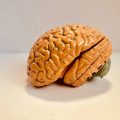Inside our thick skulls, lies perhaps the most fascinating creation in the universe. This vast bio-electrical super computer produces our thoughts, memories, behaviours and experiences of the world. There is a great deal which we have come to understand about the brain, it’s functions and abilities to process information. Here, we explore the human bodies most complex organ.
How Does it Work?
The brain is made up of over 100 billion nerve cells, each of which can connect with thousands of others via synapses. Neurons pass on their electrical and chemical messages with neurotransmitter molecules, which are received by another neuron, hence forming a pathway.
This makes for around 1000 trillion potential pathways in the brain, and it is these pathways which come to form our memories, behavioural patterns and personalities.
Breaking the Habit
The more a particular pathway is reinforced, the stronger it becomes, giving rise to our habits, good or bad. Vice versa, if a pathway is not reinforced, then it begins to weaken. When people talk of “breaking the habit”, they may actually be referring to a neurological process of breaking old unwanted pathways in the brain.
Being “set in ones’ ways” may refer to neural pathways so strongly reinforced, that they are near unbreakable. In contrast, to be “open-minded” may refer to a process of suspending usual, habitual pathways, in order to try and establish new neural connections.
Super-computer?
The brain can be seen as an information processor and is responsible for both the processing of all of our conscious input of information, and also for all of unconscious processes walking, breathing and scanning the environment constantly.
However, according to research in information theory, the brain can only absorb less than 50 bit per second during conscious activity. In human terms, this means participants in the research could read about 300 words per minute.
So much for the super-computer then; my PC can read faster than that! Well… maybe that’s not the full story!
The Unconscious Information Processor
Despite our typically human rate of reading, the unconscious workings of the brain might be where the true processing power lies.
The five senses of the body have been shown to send a massive 11 million bits of information to the brain for processing every second, most of which, given our relatively small conscious process power, is dealt with unconsciously. That’s about all of the nomorerack reviews on the planet in a second.
This flow of incoming information is thought to go through a process of compression, and accounts for the half a second gap between a particular sense receiving a stimuli, and the brain registering a reaction.
But it is not only the speed at which we can process information which is important. Our brain is also capable of producing different qualities of experience, depending on it’s current state of activity.
Brain Waves
When neurons fire, they give off electro-chemical pulses. These electrochemical pulses can be detected by an EEG brain scan, and from wave like patterns, the frequency of which are measured from delta waves through to gamma waves.
Delta waves are the slowest brain wave at 0-4Hz. This is the state of the deepest, dreamless sleep, and of the fullest rest.
Theta state is a very light sleep, or a state of extreme relaxation, and occur at 4-8Hz. This can occur in-between sleep, whilst drifting off, or sometimes whilst awake. It is the desirable state for hypnosis, affirmations etc. and has been associated with meditation.
Alpha is an awake, relaxed state, where not much information is being processed, and is measured at 8-12Hz. It occurs naturally upon waking up in the morning, and before falling asleep at night, and can be activated by conscious relaxation.
Beta state is the active wakeful state, used for engaging in most activities and work. Most people spend most of their time on beta state. It is extremely important for our everyday functioning, but can be a little difficult to “switch off”.
At 27Hz and up, Gamma is the fastest brain wave, and occurs during peak concentration, the formation of ideas, and with learning.
Taking Control
Interestingly, the state of our brain isn’t beyond our control. We have discussed the forming of neural pathways. When this is seen as a responsibilty, then we begin to make conscious choices as to what programs we would like to run, and what software we would like to install.
Our brains electrical activity is related to the collective electrical signals of our neurons, so by being responsible for our pathways we may be able to improve our brain wave states on a day-to-day basis, and live in a more relaxed state, or in a more attentive state, if that is what we require.
One method of “taking control” that has recently had much attention from researchers, is meditation. Once considered eastern mysticism, meditation has been taken up by the psychological mainstream, and is now being shown to be extremely useful for treatment of mental health.
An example of this is recent research by Dr Rick Nauert, who shows meditation to reduce anxiety in participants by 41%, also showing through brain scans an increase in activity in the ventromedial prefrontal cortex, the area which regulates our worries. This is just one small example, and the research on the subject os abundant.
Neurology, and recent technologies in brain scans, have unravelled many of the mysteries of the brain. But there is also a great deal that we don’t know yet, and understanding this complex organ may be a process that never ends; inside our brains, are all of the complexities of human thoughts, feelings, emotions, memories, and more, perhaps extending out infinitely in all directions, all at the same time, everywhere at once. Right. Stop now. You’re blowing my mind!



